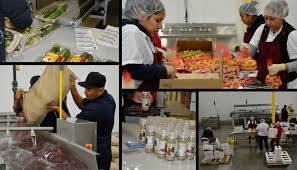As a food manufacturer, you’re thinking not only about what you produce today (and how you do that), but also about the future of food processing.
Let’s start with some United Nations numbers:
- South Africa’s population in 2010 was 50.77 million – and in 2050, is predicted to be 65.5 million (a growth of 29%)
- The global population in 2010 was 6.9 billion – and in 2050, is predicted to be 9.7 billion (a growth of 40%)
- Processed food production is predicted to grow by as much as 70% between 2010 and 2050, driven primarily by the growing middle class in China and India.
A growing South African population will clearly drive increased demand for food, including processed food. And if you can take a slice of the global food market, your profits – and production needs – will be even bigger. If you choose the latter, you’ll be extremely interested in global food trends, but even if you choose to compete in South Africa only, you’ll be aware that South Africa, sooner rather than later, follows global trends. So what are the key trends which will drive food growth in the next few decades?
The Trend Towards Healthy And Convenience Foods…
A growing, increasingly urbanised middle class (in South Africa as well as Asia) is driving awareness of the importance of eating healthy foods. Practically, this means consumers will, as they are doing in the US and other developed markets, turn to processed foods which:
- use less sugar, or sugar alternatives
- contain grains and seeds, such as flax and chia seeds, and quinoa
- use plant-based recipes (e.g. plant milks like almond milk, substitutes for meat)
- have built-in portion control (e.g. pack sizes determined by calorie content rather than mass or volume)
- are regarded as more ‘natural’ and less ‘artificial’ – so a move away from traditional processed foods oils is likely
- have some form of value-add, e.g. added vitamins, minerals, iron, calcium, high fibre, antioxidants, protein, etc.
- contain probiotics
- have ‘clean’ labels (i.e. ingredients which are easily recognised)
The trend towards health is accompanied by an increasing demand for convenience foods – a conundrum, since on-the-go foods have been, typically, not the healthiest of choices. Manufacturers which can provide healthy convenience foods will do well (and they are trying – in the US, nearly 60% of new snack launches were positioned as healthy in some way.) Examples are ‘bite-size’ food which is easier to eat on the run, and packaging which enables consumption of even hot foods without having to use cutlery.
… Will Drive The Future Of Food Processing
- Increasing logistics costs of moving ingredients will likely drive a move to sourcing ingredients as close to the point of manufacture as possible. This will not only reduce transport costs, it will also means shorter supply chains
- Recipes will increasingly include bioactive plant ingredients
- Fortified foods (with the value-adds described above) will grow market share
- The use of nanotechnology will enable improved taste and more sustainable food production (it may sound like science fiction now… but watch this space!)
- Natural and healthier ingredients will increasingly replace artificial elements
- Allergen- and gluten-free products are already commonplace – “antibiotic-free” will join that list
- Replacement of sugar with natural sweeteners
- Extended shelf life will become increasingly important – even more so if you’re exporting
Advances In Processing Equipment Will Support The Changes
The number of food manufacturers with over a hundred SKUs is growing all the time. And the number of SKU offerings consumers will demand is going to increase further. This means processing equipment is going to have to handle smaller batch processing and quick changeovers. Machinery is also likely to become more compact (probably by combining a number of operations into one), with greater automation.
Machinery will also have to comply with strict food safety legislation, inspection equipment for detecting and separating foreign particles will be increasingly integrated into production lines, and all equipment will reduce energy consumption. Self-diagnosis of problems (and potential problems) is also an area in which processing equipment will develop.
Need Help?
As a supplier of food processing equipment from a diverse range of principals, we’re on top of the changes that are coming. If you’d like to discuss your future of food processing (or current requirements), please contact us – we’d love to help you!


